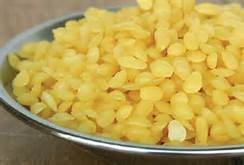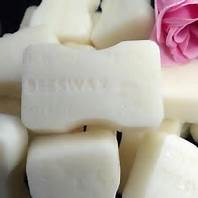Emulsifying Wax - What is?







Emulsifying Wax - What is?
Emulsifying wax is a type of cosmetic emulsifying ingredient used primarily in the manufacturing of creams, lotions, and other beauty products. The emulsification occurs when two substances — in this case, oil and water — are successfully bound together, creating a sort of glue that combines the ingredients of a product. The wax is sometimes labeled as emulsifying wax NF, which means it meets the standards of a National Formulary, which is a medical manual containing approved medicines in a particular country — the US, Britain and Australia are a few countries that have national formularies.
This type of wax is used by both cosmetics manufacturers and individuals who make their own beauty products. When included in a recipe, it thickens the liquid and marries the oil and water-based elements of the creation. The wax itself is made of either petroleum or vegetable wax that has been enhanced with a chemical detergent. It is white in color, solid, and possesses a light alcohol scent. The commonly prescribed amount of emulsifying wax NF is three to six percent of the total weight of the recipe.
All emulsifying waxes operate on a molecular plane. They act as a type of magnet, drawing the oil and water molecules together. These two types of molecules possess very different structures. Oil, for instance, is a non-polar — or water-resistant — ingredient. When it encounters the wax, oil's innate resistance to water is broken down, allowing it to blend seamlessly with the water in the recipe.
Emulsifying wax NF consists of four ingredients. These are Cetearyl Alcohol, PEG-150 Stearate, Polysorbate 60, and Steareth-20. It mirrors the properties of cetyl alcohol while promoting the thickening features of stearyl alcohol.
Cosmetic concoctions are not the only products than can benefit from this substance. It can also be used in candle making, helping to solidify the wax, glycerin, and water-based ingredients. The wax ensures the end product will hold together and burn evenly.
Some emulsifying waxes are produced from petroleum-based compounds. Many major cosmetics manufacturers utilize this form of emulsifying wax. Petroleum-derived wax is often cheaper and more readily available than its vegetable-sourced counterpart.
Vegetable-based emulsifying wax, however, is becoming more and more popular. Soy and carnauba are two types of waxes harvested from plant sources. They offer the same benefits for emulsification, and when used in candles, often burn cleaner and more evenly than petroleum wax. They consist of the natural fats and esters found in plants. It is processed into a flake-like form that is then marketed and sold. These flakes can be easily purchased in bulk to make products at home.
Reference: http://www.wisegeek.com/what-is-emulsifying-wax.htm
Articles-Latest
- Skin tags: Why they develop, and how to remove them
- So That’s Why Your Skin Gets Crepey As You Get Older
- Eye Infection from False Eyelashes
- Teeth stain removal and whitening solutions
- Benefits of collagen for skin
- Why vitamin E should be part of your skincare regime
- Can gray hair be reversed?
- Hair loss affects 1 in 10 women before the menopause – here’s how to treat it
- Conscious ageing and Black skin: What happens when Black does crack?
- Your skin color may affect how well a medication works for you — but the research is way behind
- The C word Cancer
- Astringents
- How does light therapy work? The science behind the popular skincare treatment
- The Most Offensive Fashion Police Criticisms of All Time
- Everything you need to know about lip filler migration, as told by the experts
- Pig semen and menstrual blood – how our ancestors perfected the art of seduction
- Everything you need to know about benzoyl peroxide
- We've bleached, relaxed, and damaged our hair to make ourselves look more white
- Will this be the year that facial filler is cancelled?
- Shock of the old: 10 painful and poisonous beauty treatments
Cosmetic ingredients
LOGIN
Who's On Line
We have 27 guests and no members online
Articles-Most Read
- Home
- White Bees Wax
- Leucidal
- Cosmetic Preservatives A-Z
- Caprylyl Glycol
- Cosmetics Unmasked - How Safe Are Colorants?
- Cosmetics Unmasked - Choosing Ingredients
- Cosmetics Unmasked - Colorants And Fragrances
- EcoSilk
- Toxic Beauty - Who's Looking At Cosmetics?
- Cosmetics Unmasked - Fragrances
- Microbes and Cosmetics
- Chemicals Lingering In The Environment
- Microbes and Safety Standards
- Yellow Bees Wax
- Potassium Sorbate
- Toxic Beauty - Hazardous To Your Health
- What's Happening in the USA - Cosmetic Regulations - Toxic Beauty
- Synthetics In Cosmetics - The Industry Fights Back
- Fresh Goat's Milk Soap
- Active Ingredients
- Cosmetics Unmasked - Listing Cosmetics
- Toxic Beauty - Cocktails and Low Doses
- Natural Waxes A-Z
- Natural Butters A-Z



